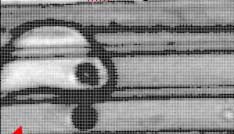For a long time, people have spoken extensively about X-rays that help detect broken bones or microwaves that heat the body, but few know about T-rays—a component of the electromagnetic spectrum—that can see through clothing, identify explosives and drugs, detect tumors, and even explore the universe.
|
A well-dressed man photographed by a millimeter wave camera. Note the gun cleverly concealed. The T-ray camera is said to be similar but stronger. (Image: LiveScience) |
The electromagnetic spectrum extends from long-wavelength radio waves to short-wavelength, high-energy X-rays and gamma rays. Positioned between microwaves and X-rays, in the least researched region of the spectrum, are T-rays, or terahertz radiation—the most prevalent type of radiation in the universe.
If you have never heard of T-rays, it is because scientists have faced challenges in harnessing them. Although the first scientific paper on the subject was published in 1890, even today, researchers still confront difficulties in studying and developing technologies to generate, detect, and control T-rays.
With more sources and efficient terahertz radiation detectors, researchers have begun developing filters and generators to control T-rays over the past decade.
“At this point, the technology is still very young. Terahertz is currently like X-rays in 1905,” commented electrical engineer Daniel Mittleman from the T-ray laboratory at Rice University.
Many common materials, such as clothing, plastic, and wood, become transparent under terahertz imaging. Additionally, materials absorb this radiation at different frequencies, depending on their type. Based on the absorption frequencies—unique characteristics akin to fingerprints—researchers can identify certain explosives and drugs.
For example, an envelope containing a mysterious white powder may appear dangerous to the naked eye. However, with the help of T-ray imaging, postal workers can quickly determine whether this powder contains aspirin or methamphetamine (a narcotic). Explosives can also be easily identified, even if cleverly hidden in bags.
 |
T-ray imaging shows scratches on a car’s fender that conventional images do not reveal. (Image: LiveScience) |
This technology is also being used in some hospitals as a new, non-invasive diagnostic tool for detecting tumors. This technique will reduce costs and pain compared to previous diagnostic methods.
Meanwhile, scientists at the University of Liverpool in the UK hope to destroy skin cancer cells by exposing them to terahertz radiation. Tobacco manufacturers like Philip Morris are exploring new ways to use T-rays for quality control in factories.
Pharmaceutical companies are also utilizing high-tech solutions to adjust drug content without needing to handle it directly. Terahertz imaging techniques can even measure the thickness of the coating on a pill.
With the help of a T-ray imaging system developed by Michigan-based Picometrix, NASA can detect small defects in the insulating foam of space shuttles. Additionally, T-rays have many other important astronomical applications. The Herschel Space Observatory, a satellite expected to launch in 2008, is the terahertz version of the Hubble Telescope. In Chile, the ALMA center is also being built to monitor terahertz wavelengths with the hope of discovering objects from the primordial stages of the universe.

T-rays used to image a leaf
when dehydrated and after rehydration
(Image: LiveScience)
T. An



















































